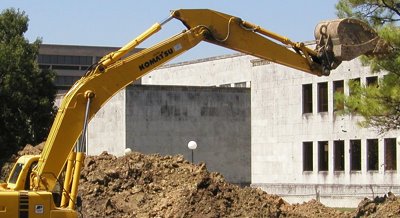Excavating for Books
 Today, we break ground. The University of Houston's College of Engineering presents this series about the machines that make our civilization run, and the people whose ingenuity created them.
Today, we break ground. The University of Houston's College of Engineering presents this series about the machines that make our civilization run, and the people whose ingenuity created them.
This fall of 2002, I walk back from lunch along the south side of our library, as I always have. But in the last few days, a new sight greets me. A large Komatsu PC300LC excavator has appeared, and it's tearing into the lawn behind a wire mesh fence.
The ground is finally being broken for the new wing of our library, after years of working to make it happen. We're still a few million dollars short on this terribly important project, but more people who care about this University will rise to that challenge.
For now, my mind is on that excavator. It's not large, as excavators go -- less than forty tons. Komatsu makes one that's 750 tons, with buckets that can lift the weight of two PC300 excavators. But this PC300 is dramatic enough. It can lift a load of dirt as heavy as a large automobile.
The arm that carries the bucket is a lot like your arm, with all its articulation. The shoulder is next to the cab. The elbow is located just beyond half the arm's length. At the end, the bucket attaches like a hand. It can be extended some thirty feet.
And it's as expressive in its motion as a human arm. The operator is an artist. He parks beside the section he's shaping and molds it just as a sculptor would. We really are watching a human arm in motion.

The bucket cuts out soil down to a certain level, carries it over to a pile, and shakes it off, as you might shake garden soil off your hand when you're planting bulbs. The operator uses a delicate backhand motion to smooth the section he's hollowed out. He uses the teeth on his bucket like human fingernails, flicking away clods of dirt.
The excavator arm really is an amplification of the operator's own movements. He's not some sort of specialized truck driver, but a bionic man. His thoughts translate into the machine's motion. Reality seems to take a strange turn to the left as I watch.
A vastly expanded library will rise here. Books and students will fill it and energize it. The works of Socrates and Kant, Darwin and Schrödinger, O'Neill and Albee will mold minds on this spot. Computers will connect ideas. The quiet reaches of the new building will invite minds to stretch and reach. This place where we share our ownership of books and ideas will make books and ideas far more than they could ever be in isolation.
But now I watch that same delicacy of cooperation, expressed in the well-made machine from which the building begins. I watch balance and motion, design and ergonometry, theoretical mechanics and hand-eye coordination.
Not from nothing does any great building spring. One day, when we all heave a sigh of relief and break our champagne bottle upon the finished building (or whatever it is one does), my mind will go back to that great yellow android providing the first, and lasting, metaphor for what we embark upon here.
I'm John Lienhard, at the University of Houston, where we're interested in the way inventive minds work.
(Theme music)
